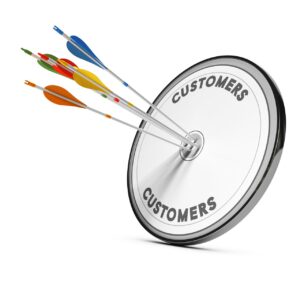In the competitive landscape of field sales, the ability to prospect effectively is nothing short of crucial.
Today’s blog post is your comprehensive guide to field sales prospecting, with a clear focus on overcoming common challenges you might encounter. Drawing from years of experience and industry knowledge, we’ll delve into strategic approaches that promise to transform your prospecting game.
Understanding the Importance of Field Sales Prospecting
Sales prospecting, especially field sales prospecting, is about more than just selling a product or service. It’s about forging lasting relationships, identifying potential opportunities, and strategically positioning your offerings to address a prospect’s specific needs.
These tasks require a combination of keen acumen, persistent effort, effective communication, and innovative strategies.
Prospecting is the bedrock of any successful process. A well-executed prospecting strategy enables field representatives to fill their sales pipeline with potential clients who may be interested in their products or services.
- Foundation for Success: Prospecting is the cornerstone that supports the entire process. It sets the stage for success, helping teams identify and engage with potential clients.
- Filling the Sales Pipeline: With effective prospecting, representatives can consistently fill their pipeline with high-quality leads. This constant flow ensures that there’s always a new opportunity on the horizon.
- Adapting to Changes: The sales landscape is ever-changing, with new challenges like remote work and emerging technologies. Effective prospecting allows sales reps to adapt and thrive in this dynamic environment.
- Avoiding a Dry Funnel: Without targeted prospecting, the sales funnel can quickly run dry. This situation can lead to decreased revenue and stalled growth, a scenario that no representative wants to face.
- Enabling Growth and Expansion: Ultimately, effective prospecting is a key driver for business growth and expansion. It empowers teams to reach new markets, connect with diverse clients, and build lasting relationships that fuel long-term success.
- Enhancing Customer Engagement: Effective prospecting goes beyond just identifying leads; it involves understanding customer needs and preferences. Sales reps who excel in prospecting can create more personalized and engaging interactions, leading to stronger connections with potential clients.
- Optimizing Time and Resources: In the highly competitive field of sales, time is money. This optimization of time and resources can significantly increase the efficiency of the process, allowing reps to achieve more in less time.
But what happens when you face challenges in your prospecting efforts? How can you navigate these challenges and ensure a successful prospecting process?
I. Identifying Quality Prospects
Identifying quality prospects is a critical task for field sales teams, but it comes with its own set of challenges.
Defining Ideal Customer Profiles (ICPs) requires an understanding of existing customers, market trends, and an analysis of data to pinpoint high-quality prospects accurately. A lack of technological integration can further complicate this process, leading to lost opportunities and misalignment with the target audience.
Sales reps must continually revise and adapt their ICPs to stay relevant, making it a demanding and ongoing task.
Failure to identify quality prospects properly can lead to several detrimental effects. Firstly, it results in wasted efforts, targeting leads that do not align with the company’s offerings, leading to decreased efficiency.
This misalignment might also cause a disconnect in messaging, hindering the ability to resonate with potential customers. Over time, this could diminish the reputation of the sales team, and consequently, the entire company.
Moreover, without a continuous revision of the ICPs, a business might lose its competitive edge in an ever-changing market. Ultimately, a poorly executed identification process can lead to a dry sales pipeline and a significant drop in revenue and growth.
Tips to Identify High-Quality Prospects
- Creating Detailed Buyer Personas: By understanding the characteristics, motivations, and behavior patterns of ideal customers, sales teams can create targeted and effective strategies.
- Utilizing Technology for Prospecting: Leveraging tools like CRM systems, AI, and automation can streamline the prospecting process, making it more efficient and personalized.
- Regular Review and Revision of ICPs: Continuously revisiting and revising ICPs ensures alignment with changing market conditions and business growth.
- Training and Education: Regular training sessions and educational materials can help sales reps stay current with the latest techniques and tools in identifying quality prospects.
- Collaboration with Marketing: Working closely with the marketing team can ensure that the efforts are aligned, and quality leads are generated through a unified strategy.
- Data-Driven Decision Making: Using analytics and data to guide prospecting efforts can significantly enhance the quality of leads and tailor messages effectively.
- Personalized Communication Strategy: Crafting tailored messaging that resonates with the identified ICPs can improve engagement and conversion rates, fostering stronger connections with potential clients.
With these strategies, field sales teams can successfully navigate the challenges of identifying quality prospects, ensuring a vibrant sales pipeline, and achieving growth and success in the competitive marketplace.
II. Gaining Access to Decision-Makers
Gatekeepers, who are individuals controlling access to decision-makers, often present the first obstacle, as they are tasked with filtering out irrelevant pitches.
Building rapport with potential clients requires a genuine understanding of their needs, challenges, and goals, and it can be a time-consuming process.
Failure to gain access to decision-makers can lead to significant roadblocks in the process. If a sales rep cannot get past the gatekeepers or fails to build rapport with prospects, opportunities are likely to be lost.
Building trust and understanding with potential clients is crucial for effective pitches. Without it, pitches may seem insincere or irrelevant, impacting individual sales and the company’s reputation. It can also lead to longer sales cycles, wasting resources and time.
Ultimately, not being able to reach and engage decision-makers can result in decreased conversions, missed targets, and a demotivated sales team.
Recommendations for Gaining Access to Decision-Makers
- Understanding Gatekeepers: Recognizing the role and influence of gatekeepers helps in treating them as allies. Being polite and ready to explain your value succinctly can turn them into valuable connections.
- Building Rapport Through Empathy: Understanding and acknowledging the prospects’ needs, challenges, and constraints builds trust and credibility. It opens doors for more meaningful conversations.
- Effective Handling of Objections: Training and practice in addressing objections with clarity and confidence help in maintaining the interest of the prospect.
- Utilizing Referrals and Networking: Leveraging existing connections and seeking referrals can ease the process of reaching decision-makers.
- Providing Clear and Relevant Value Propositions: Articulating how your product or service can specifically address the challenges faced by the prospect makes your pitch more appealing.
- Consistent Follow-up and Communication: Regular and thoughtful follow-ups can keep the conversation alive and progressively build the relationship with decision-makers.
- Utilizing Social Media and Professional Networks: Engaging with prospects on platforms like LinkedIn or industry forums can provide additional avenues to connect and understand their needs better.
With these strategies, field sales reps can successfully navigate the challenges of gaining access to decision-makers. The process requires patience, empathy, and a well-articulated value proposition, but with determination and skill, these barriers can be overcome, leading to fruitful relationships and successful sales.
III. Navigating Long Sales Cycles
Field representatives often find themselves navigating intricate and prolonged sales cycles, particularly in industries that demand regulatory compliance or involve complex decision-making processes.
Understanding the typical stages of these sales cycles and recognizing the factors that influence them is a complex task.
The challenge grows when attempting to shorten the cycle without harming relationships, or when dealing with complex sales that involve multiple stakeholders. Managing the balance between persistence and pressure while trying to build long-term relationships adds another layer of complexity to this multifaceted issue.
Failure to properly navigate long cycles can result in inefficient use of resources, missed opportunities, and potential damage to customer relationships.
A lack of understanding of the sales cycle may lead to improper planning, causing delays, or missed cues that might otherwise accelerate the process. Prolonged cycles can inflate costs and tie up sales teams, hindering them from pursuing other opportunities.
Failure to recognize and address prospects’ specific needs may lead to a lack of trust and loyalty. Mishandling persistence, and applying too much pressure, can turn potential clients away.
Ultimately, the inability to manage long cycles effectively can undermine revenue growth, erode customer satisfaction, and negatively impact the reputation of both the representative and the organization.
Tips to Strategically Navigate Long Sales Cycles
- Understanding Factors and Stages: Gaining insights into the typical stages of the sales cycle and the specific factors influencing them helps in planning and pacing efforts.
- Implementing Strategies to Shorten Sales Cycles: Techniques like pre-qualifying leads, utilizing technology for automation, and sharing exceptional content can make the process more efficient.
- Managing Complex Sales with Research and Personalization: Approaching complex sales with a deep understanding of the organizational structure, goals, and pain points, coupled with a personalized strategy, can significantly improve outcomes.
- Balancing Persistence and Pressure: Listening to prospects, recognizing their needs, and tailoring follow-ups helps in striking the right balance between persistence and undue pressure.
- Building Long-Term Relationships through Communication and Value: Regular communication, consistent value provision, and acting on feedback are key to creating lasting connections and fostering customer loyalty.
- Recognizing and Responding to Prospect Needs: Attentively listening to prospects and tailoring offerings to address their specific challenges speeds up the cycle and builds trust.
- Utilizing Technology and Content for Education: Leveraging modern tools to educate prospects about offerings helps them move through the decision-making process faster, shortening the cycle, and enhancing the relationship.
The journey of navigating long cycles is filled with nuances, requiring strategic thinking, patience, and empathy. But with these thoughtfully devised strategies, field reps can turn the complexity into an advantage, crafting personalized and efficient pathways to success.
It’s a testament to the art of sales, where understanding, relationship-building, and smart execution converge to create long-term value for both clients and organizations.
IV. Overcoming Rejections and Handling Setbacks
Field representatives frequently grapple with rejection and setbacks, which are inevitable parts of the process. Bouncing back from these experiences, staying positive, and utilizing rejection as a learning tool are common challenges for many sales professionals.
Additionally, creating a supportive professional network and committing to continuous learning and improvement in the fast-paced, ever-changing sales landscape present their own sets of difficulties.
Further, the task of seeking, accepting, and implementing feedback in a constructive manner to enhance performance adds another layer of complexity to the role of a field rep.
Failure to effectively handle rejection and setbacks can lead to decreased morale, productivity, and ultimately, suboptimal performance.
Without a positive outlook and resilience, a sales rep can become discouraged, hindering creativity, problem-solving abilities, and persistence. If not surrounded by a supportive network, sales reps might struggle to cope with the challenges and pressures of their role, leading to stress and potential burnout.
A lack of continuous learning and adaptation to the evolving sales landscape can result in outdated skills and missed opportunities.
Moreover, not encouraging or implementing feedback might limit personal and professional growth, and prevent the achievement of optimal performance. In the long run, all these factors could result in reduced conversions, lower customer satisfaction, and a possible decline in an organization’s market position.
Recommendations for Overcoming Rejections and Handling Setbacks
- Cultivating Resilience: Embrace rejection as a learning opportunity. Ask for feedback when deals don’t close to understand how to improve.
- Maintaining a Positive Outlook: Keep a positive attitude, remembering that each “no” is a step closer to a “yes.” A positive mindset can enhance your resilience and overall effectiveness.
- Building a Supportive Network: Surround yourself with supportive colleagues and mentors. Share experiences, learn from others, and celebrate successes to build resilience and a positive work environment.
- Committing to Continuous Learning: Recognize that the sales landscape is ever-changing. Constantly identify areas for growth and invest in learning new skills or tools.
- Investing in Ongoing Training and Development: Make continuous learning a part of your routine. Seek feedback, learn from failures, and constantly aim for improved performance.
- Implementing Feedback Constructively: Encourage and accept feedback from customers, peers, or supervisors. Use it as a guide for development and performance enhancement.
- Adopting a Growth Mindset: Treat setbacks as opportunities for growth rather than failures. This mindset can make you more resilient, innovative, and successful in your sales role.
Overcoming rejection and handling setbacks is more about mindset and strategy than just determination. With resilience, a supportive network, continuous learning, and a feedback-friendly environment, every field rep can transform challenges into opportunities and setbacks into stepping stones to success.
Remember, the ability to bounce back and learn from adversity is what differentiates an ordinary sales rep from a truly exceptional one.

V. Embracing Technology and Tools
The modern sales environment demands the integration of various technological tools, but this integration is not without its challenges for field representatives.
The selection of appropriate tools, understanding their functionalities, and adapting them to the daily workflow can be difficult. Moreover, the continuous evolution of technology necessitates regular updates and training to stay competitive.
Field sales reps also face challenges in effectively leveraging CRM, mobile tools, and automation to their fullest potential to maximize efficiency and responsiveness in their approach.
Failure to embrace technology and tools properly in the field sales landscape can lead to inefficiencies, missed opportunities, and a competitive disadvantage.
Without integration of CRM and analytics, sales reps may lack real-time insights to capitalize on prospects’ interests, leading to slower response times and potential loss of conversions.
Neglecting mobile tools and automation can make field sales reps less agile and burden them with routine tasks that consume valuable time. Selecting inappropriate tools or failing to train the team properly can result in wasted investments and suboptimal prospecting success.
Furthermore, not staying updated with the latest technological trends might render a sales team’s strategies outdated. Collectively, these shortcomings can hinder the overall success and growth of the sales organization.
Tips to Properly Embrace and Utilize Technology and Tools
- Integrating CRM and Analytics: Understand and utilize CRM systems to manage relationships and track conversions. Integrating analytics will provide actionable insights that guide your strategies.
- Leveraging Mobile Tools: Embrace mobile tools that allow you to carry your office wherever you go, adding agility and responsiveness to your approach.
- Utilizing Automation: Implement automation tools to handle routine tasks. This allows you to focus on critical aspects of the process, managing time more effectively.
- Selecting the Right Tools: Analyze your process and identify areas where technology can add value. Choose tools that align with your specific needs for maximum prospecting success.
- Investing in Training and Support: Ensure that your team is trained to use the selected tools effectively. This can be done through in-house training or vendor support.
- Staying Technologically Updated: Keep up with the latest tools, trends, and updates. Regularly review and update your tech stack to keep your strategies fresh and competitive.
- Emphasizing a Technology-Driven Culture: Cultivate a culture that recognizes and celebrates the role of technology in modern sales. Encourage continuous learning, experimentation, and adaptation to new technological innovations.
Remember, embracing technology in your process can be a game-changer, enabling greater efficiency, personalization, and success.
Technology is your ally on the path to excellence; embrace it, master it, and let it drive you forward.
Final Thoughts | Mastering Target Locking
Field sales prospecting is a complex yet rewarding endeavor. From identifying prospects to handling rejections, every step of the journey offers unique challenges and opportunities.
In this comprehensive guide, we’ve explored ten strategic approaches to overcome common hurdles in field prospecting. By understanding your prospects, embracing technology, building resilience, and fostering continuous growth, you can master the art of field sales prospecting.
Remember, the key to success in sales lies in continuous learning, strategic thinking, and a relentless pursuit of excellence. Equip yourself with these tools and insights, and watch your field sales game reach new heights.
To start, book your free demo with Beest.app – a trusted and reliable field sales management software.
Frequently Asked Questions
What challenges are faced in field sales prospecting?
The main challenges include reaching decision-makers, dealing with long sales cycles, handling rejection, embracing technology, and choosing the right tools. Our blog post provides strategic approaches to overcome these obstacles and improve efficiency.
Can technology make a difference in field sales prospecting?
Absolutely! Technology plays a vital role, saving time, increasing efficiency, and enhancing personalization, as discussed in our blog post.
Do these strategies apply to sales newcomers?
Yes, they are designed for both newcomers and seasoned professionals. Implementing them can build a strong foundation and help overcome common challenges effectively.
How to manage long cycles in my industry?
Manage long cycles by understanding industry stages, planning accordingly, and employing strategies to shorten the cycle if needed. Our blog post offers insights and actionable strategies for different industries.
How to become more resilient in sales?
Build resilience by learning from rejections and maintaining a positive outlook. Our blog post guides you on viewing rejection as a growth opportunity and developing a strong support system.
How to ensure that selected tools suit my needs?
Select the right tools by analyzing your process and identifying where technology can add value. The blog outlines how to align tools with your specific needs and provides guidance on training and support.
Are these approaches applicable to different industries?
Yes, the strategic approaches discussed in this guide are versatile and can be applied across various industries. They offer a flexible framework to address unique needs and challenges.




